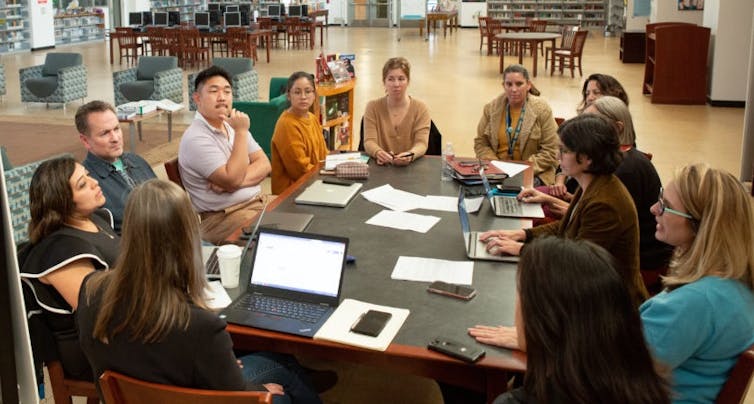Debates among researchers, educators and parents continue about the successes and challenges with French immersion programs across English-speaking parts of Canada.
Programs are criticized for being elitist by some and praised for being exceptional by others.
My master’s research showed how Ontario and Toronto French immersion policies exacerbate inequities, finding that program locations favoured middle-class students, curricula demonstrated a Eurocentric focus and colonial lens and program entry-points favoured established residents over newcomers.
My PhD work research has relied upon a collective creation research method known as “playbuilding” to propose ways French immersion programs can be more culturally responsive and anti-racist.
Issues in French immersion
Research about students in Alberta has shown that language levels of French immersion graduates are low and many lack confidence in their French skills.
French immersion programs have been known to exclude many students, particularly those with special education needs, multilingual learners, immigrants and lower-income students. In the past, some immersion programs even required IQ testing for admission.
With immersion programs in Toronto mainly found in white, middle-class areas, it is unsurprising that white, middle-class students are the most present in Toronto programs.
In the Toronto District School Board, research about French immersion enrolment shows inequitable demographics have been improving in terms of racial and multilingual representation of enrolled students. However, it also shows programs remain dominated by white, middle-class, anglophone students with few learning exceptionalities.
(Allison Shelley for EDUimages), CC BY-NC
Documenting student experiences
French immersion is a heavily researched program; however, research has largely ignored racial identity and racism.
I invited French immersion stakeholders (like teachers, parents, staff and professors in teacher education programs) to engage with stories of racial minority students in Ontario French immersion programs, and my own experiences as a racialized French immersion teacher.
Firstly, my online study recruited two Black and one South Asian French immersion students from Ontario, aged 16–20. Over the course of two weeks, participants created monologues and wrote stories about their experiences as racial minority students in French immersion programs. Stories and monologues are available on our website.
In the second stage of research, 39 French immersion stakeholders (students, teachers, parents, staff and professors in teacher education programs) viewed our website and responded to an online survey reacting to stories and suggestions for improving immersion. The findings from stage two support the findings from stage one.

(Allison Shelley for EDU images), CC BY-NC
Cultural learning and representation
Cultural learning is required by the French as a second language (including French immersion) curriculum. Each grade focuses on different local or global cultures to help develop students’ intercultural competence.
For example, Grade 1 French immersion focuses on local francophone communities, Grade 8 focuses on France and Grade 10 focuses on French-speaking Africa and Asia. No matter the cultural focus, the curriculum calls for the inclusion of “diverse French speaking communities” in every grade.
Students in my study recounted that they did not learn about diverse French cultures. In some cases, they were not discussing culture at all. Students’ own cultures and races were also absent from their learning.
The representation in students’ learning was overwhelmingly white and European or Québécois. The lack of diversity is not representative of the curriculum or the reality of the French speaking world, which is over 50 per cent people of colour.
Unchecked racism
In a racially structured and racist society, the presence of racism in immersion programs is hardly shocking. However, the participants revealed many instances where racism could have been interrupted and was not.
In general, participants’ schools had a culture of racism where racist acts and speech (committed by students, teachers and administrators) were allowed to continue unchecked.
In many cases, teachers were not willing to intervene when racist incidents occurred in their French classes. In one case, a teacher even let a student use a racist French term repeatedly.
A few participants expressed that some teachers and administrators interrupt racism. However, even these teachers were not integrating anti-racist teaching (that is, integrating diverse racial representations and empowering students to combat racism and oppression).
Black youth yearn for Black teachers to disrupt the daily silencing of their experiences

(Allison Shelley for EDU Images), CC BY-NC
Call for change
Students should not be subjected to racism and should be learning about the diverse realities of the French-speaking world so they can see themselves as legitimate French speakers.
Listening to the voices of racial minority students in French immersion programs in dialogue with research documenting program inequities is an important step towards creating more inclusive French immersion programs and schools.
The preliminary findings of my study, in conjunction with earlier research documenting a Eurocentric focus and colonial lens in Ontario and Toronto immersion programs, point to the need for supporting anti-racist and culturally responsive teaching and intercultural awareness to make programs more welcoming to all students.




